Gifting has never been easier
Perfect if you're short on time or are unable to deliver your gift yourself. Enter your message and select when to send it.

Cart
Your cart is empty
“What is rattan?" is a common question that many people have. Rattan is a naturally renewable palm that grows in the tropical regions of Africa, Asia, and Australasia. It is used for furniture, handicrafts, and building materials, among others. Let's explore more details about rattan in the following article with Rowabi!
Facts:
What is rattan? Rattan is a natural material derived from a flowering plant belonging to the palm family, predominantly found in Southeast Asia, with some presence in Africa. It is highly valued for its unique characteristics, including durability, lightweight nature, and waterproof properties.
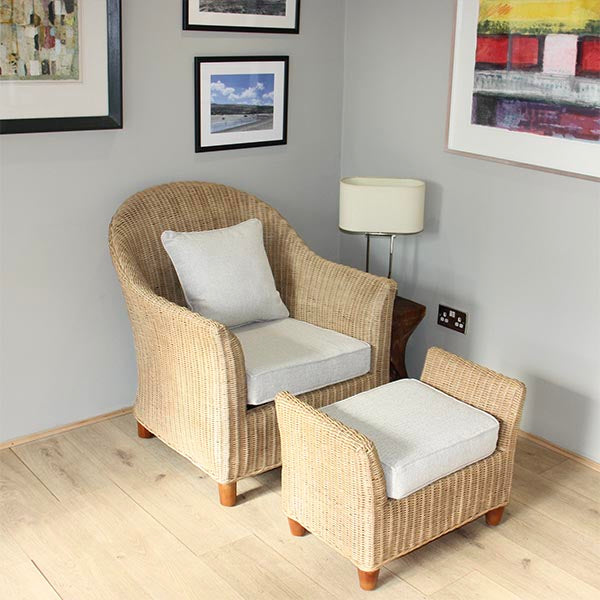
Rattan is a natural material from a palm-family plant found in Southeast Asia and Africa
These qualities make it an excellent choice for outdoor furniture, such as lounge chairs, sofas, and dining chairs. Rattan's ability to withstand various weather conditions also makes it suitable for spaces that have indoor/outdoor climates, such as sunrooms and gazebos.
Rattan primarily originates from tropical regions, with the majority of species found in Southeast Asia. Countries such as Indonesia, the Philippines, Malaysia, and Thailand are the largest producers of rattan. Indonesia alone accounts for nearly 70% of the global supply, making it the world's leading source.

Rattan is primarily found in Southeast Asian countries and is commonly used in furniture-making. Source: Atelier Mazine
These countries have vast tropical forests where rattan grows abundantly as a climbing palm. Although rattan is also found in parts of Africa and Australasia, Southeast Asia remains the principal region for rattan production due to its optimal growing conditions and long-standing cultivation practices.
The process of making rattan furniture begins with harvesting the rattan cane from the forests. Once harvested, the canes are cleaned and dried. The outer skin, known as the rind, is often peeled off to produce "cane," while the inner core is used for various purposes.
The canes are sometimes boiled in oil or treated with chemicals to enhance their durability and prevent insect damage.
After processing, the rattan canes are split into smaller strips or used whole, depending on the furniture design. These pieces are then bent and shaped, often using steam to make them more pliable.
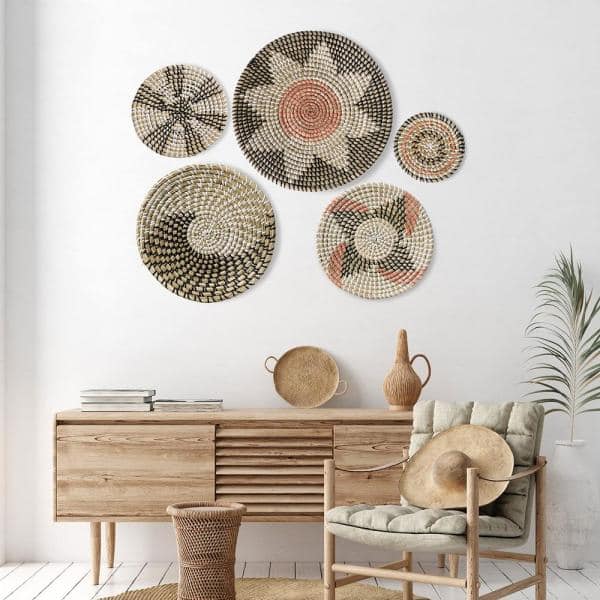
High-quality rattan decor and furniture are carefully handwoven by the best artisans
Artisans use various tools to shape the rattan into the desired shapes for furniture frames. The shaped pieces are assembled into furniture items such as chairs, tables, and sofas, using screws, nails, or binding materials like leather or twine.
Finally, the furniture is sanded to smooth out any rough edges and then stained or painted to achieve the desired finish. A protective coating is often applied to enhance durability and give the furniture a polished look.
Let's find out what defining characteristics make rattan a popular choice for both furniture makers and consumers, valued for its functionality and aesthetic qualities.
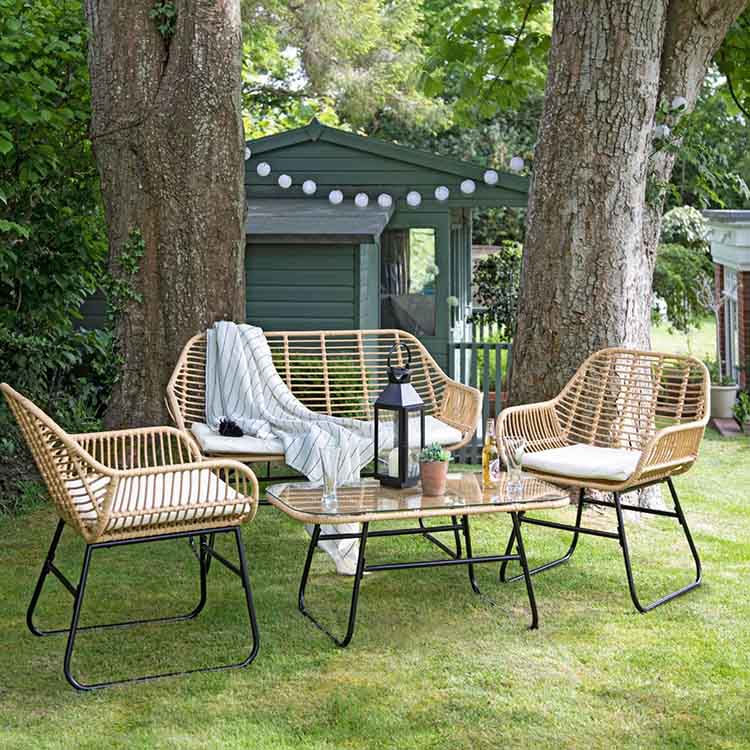
Rattan possesses excellent characteristics that make it ideal for crafting top-quality furniture pieces. Source: Laura James
Rattan is a versatile material that finds frequent applications in various fields due to its unique properties and characteristics. It is widely utilized for a wide range of purposes, including:
Rattan is a highly sought-after material in the furniture industry due to its versatility and aesthetic appeal. Rattan furniture includes items like chairs, sofas, tables, beds, and cabinets, all crafted from this durable and lightweight material. These pieces are cherished for their natural charm and durability, making them ideal for both indoor and outdoor settings.
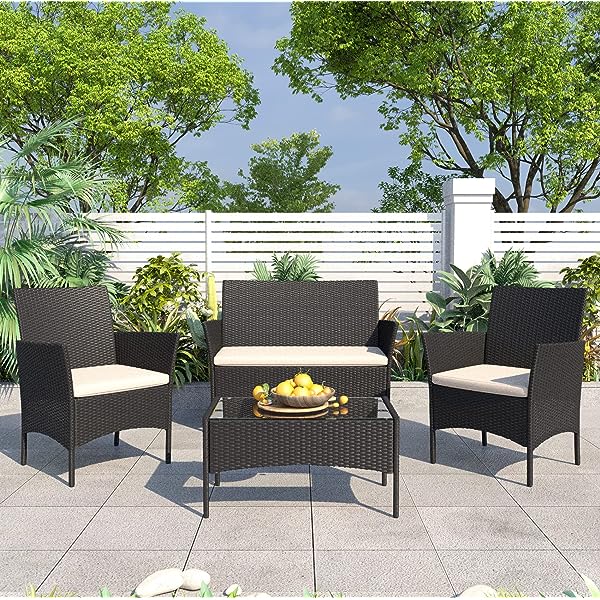
Rattan's natural resistance makes it ideal for garden and patio furniture
Incorporating rattan furniture and decor allows homeowners to enjoy the material's beauty and functionality in diverse environments, providing elegant and long-lasting options.
Aside from its utility in furniture, rattan also finds its way into the world of lighting fixtures. Pendant lights, chandeliers, and lampshades crafted with woven rattan elements showcase the distinctive and natural beauty of this versatile material.
Rattan lighting fixtures bring a unique touch to interior lighting designs, casting captivating patterns of light that add a charming and organic ambiance to any space. The interplay of light and rattan creates an enchanting display of shadows and textures, adding depth and character to the overall aesthetic. When illuminated, these fixtures create a warm atmosphere.
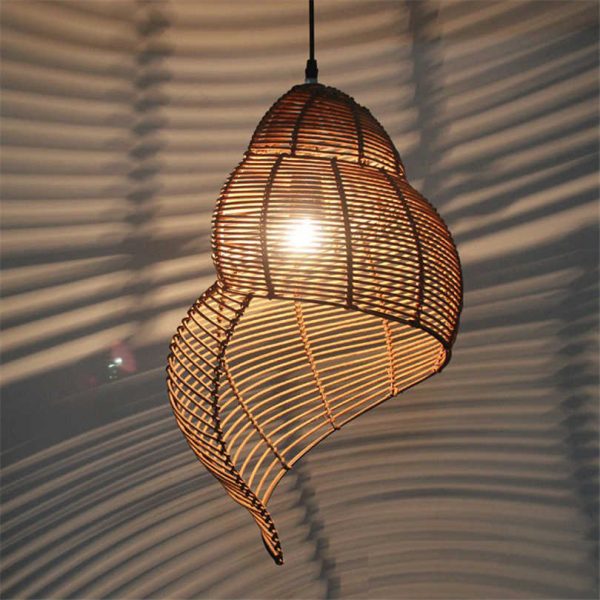
Rattan also finds its way into the world of lighting fixtures
Furthermore, rattan lighting fixtures are not only visually appealing but also environmentally friendly. Rattan is a renewable and sustainable material, making it an excellent choice for those who are conscious of the environmental impact of their choices.
Rattan is extensively used in handicrafts and arts, creating items such as baskets, mats, and decorative pieces. Its flexibility and strength allow artisans to weave intricate patterns and designs.
Additionally, rattan weaving is a traditional craft in many cultures, particularly in Southeast Asia. The craftsmanship involved in rattan weaving is highly regarded, making these items popular in both local markets and international exports.
In many tropical regions, rattan is a crucial building material. Its long, sturdy canes are used to construct shelters, roofs, and walls, providing a sustainable and eco-friendly option for housing. Rattan can be easily harvested and replenished, making it a renewable resource.
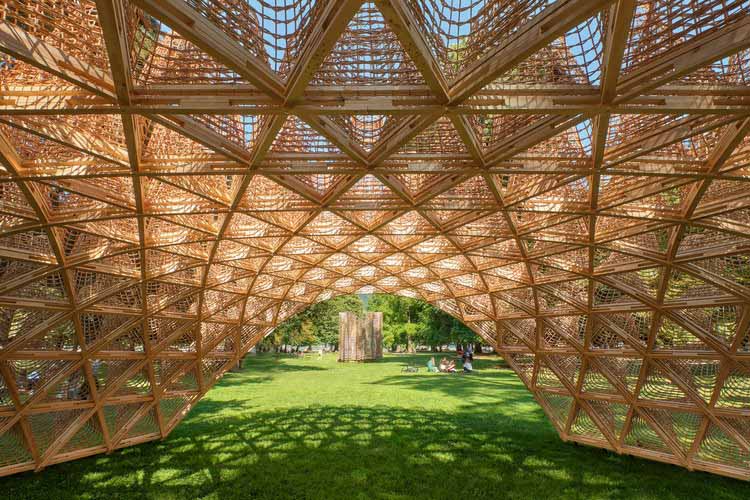
Rattan can also serve as sturdy shelter material for various structures
Traditional stilt houses and other indigenous structures often incorporate rattan for its durability and resistance to tropical weather conditions. The material’s natural resilience to rot and pests makes it a reliable choice for construction in humid climates.
Historically, rattan has been used to craft traditional weapons and tools. Its strength and flexibility make it ideal for creating items like walking sticks, staffs, and practice swords for martial arts.
For example, in Filipino martial arts like Eskrima, rattan sticks are used for training and sparring due to their durability and the fact that they don’t splinter upon impact. These weapons are essential for developing skills and techniques in various martial arts disciplines.
Certain species of rattan produce edible shoots, similar to bamboo shoots. These shoots are harvested and consumed as a vegetable in various Southeast Asian cuisines. Known for their crunchy texture and mild flavor, rattan shoots are often used in soups, stir-fries, and salads.

The Assamese-style rattan shoots are quite popular as a food choice
They are also considered nutritious, providing a good source of fiber, vitamins, and minerals. Harvesting rattan shoots for food is a sustainable practice that supports local economies and culinary traditions.
Rattan has been used in traditional medicine for its purported health benefits. Various parts of the plant, such as the roots and shoots, are believed to have medicinal properties. Traditional remedies utilize rattan to treat ailments such as joint pain, inflammation, and digestive issues.
Rattan fibers are sometimes used in the creation of traditional clothing and accessories. The flexible nature of rattan makes it suitable for weaving into hats, belts, and other wearable items. In many cultures, rattan is incorporated into ceremonial attire and everyday garments.
Sports equipment
In sports, rattan is used to make durable and lightweight equipment. It is commonly used in the production of canes for martial arts, as well as in traditional sports such as sepak takraw, where the ball is woven from rattan strips.
Owning natural rattan furniture and decor offers numerous benefits, making it a popular choice for many homeowners. Here are some key advantages:
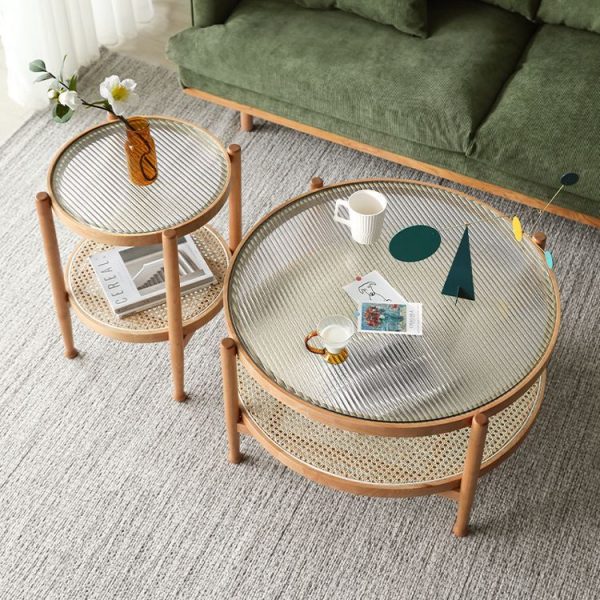
Rattan has minimal maintenance requirements, which is advantageous
Rattan - almost no maintenance
Aesthetic appeal
Weather resistance
Comfort
Durability
Cost-effectiveness
Eco-friendly
Rattan, wicker, cane, and bamboo are frequently interchanged in conversations about furniture and decor, yet they each possess distinct qualities. We'll assist you in comparing and distinguishing them through the following table:
| Aspect | Rattan | Wicker | Cane | Bamboo | ||||
| Material |
|
|
|
|
||||
| Texture |
|
|
|
|
||||
| Flexibility |
|
|
|
|
||||
| Usage |
|
|
|
|
||||
| Strength |
|
|
|
|
||||
| Origin |
|
|
|
Cultivated in diverse climates globally, with major producers including China and India |
Furniture crafted from rattan boasts a rich history dating back to ancient civilizations, where its strength and flexibility were highly prized.
Like wicker, which was first unearthed with pharaohs in ancient Egypt, rattan also captivated the Romans, who adopted it as their own technique after being inspired by Egyptian woven furniture.
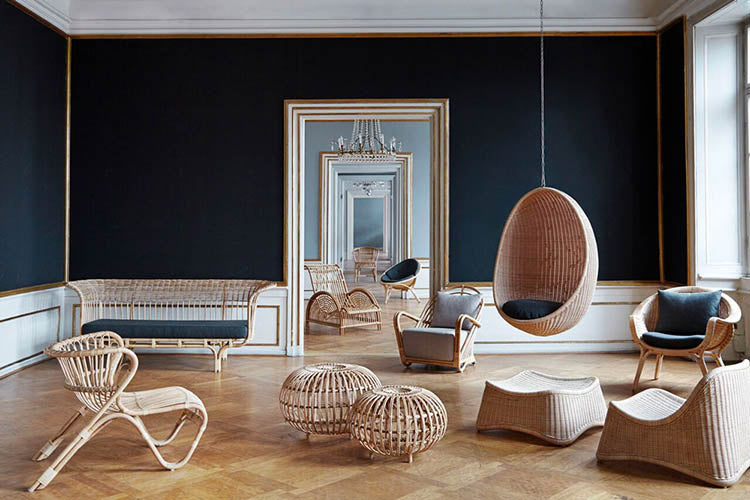
Rattan furniture also took a lot of time to achieve its current status in the interior design world
However, it wasn't until the early 19th century that rattan furniture became an integral part of American craftsmanship. In the 1840s, Cyrus Wakefield founded the first rattan furniture company in South Reading, Massachusetts, marking a pivotal moment in its evolution.
During the Victorian era, rattan furniture became synonymous with elegance and luxury, adorning the parlors and conservatories of the upper class in Europe and America. In the early 20th century, rattan experienced a resurgence with the emergence of the Art Deco movement, as designers embraced its organic aesthetic in modernist furniture pieces.
The mid-century modern movement further propelled the popularity of rattan, with designers exploring its flexible properties to create iconic chairs and lounges. Today, rattan furniture and decor continue to captivate homeowners and designers alike, thanks to its timeless charm, eco-friendly nature, and versatility in complementing various design styles.
Rattan is not limited to just outdoor furniture. It is commonly used to create a variety of indoor furniture pieces as well. Here are some examples of furniture made from rattan:
What is rattan? Rattan is a type of flexible climbing palm often used to weave intricate patterns for pendant lights. Rattan pendant lights are a popular choice when it comes to incorporating natural elements and unique designs into interior lighting. By weaving rattan strands into intricate patterns, craftsmen create stunning pendant lights that exude a sense of elegance.
The woven rattan patterns allow for a soft and diffused glow to emanate from the light source, creating a cozy and inviting atmosphere in any room. The natural color and texture of rattan add depth and visual interest to the pendant lights, making them a focal point and a conversation starter in interior design.
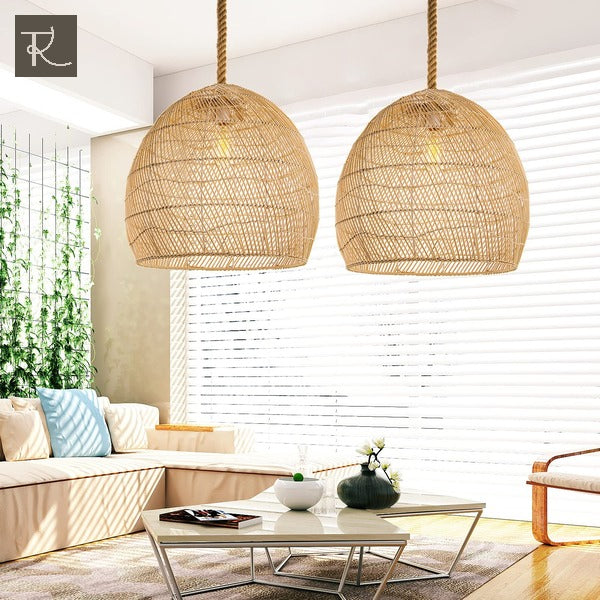
Rattan pendant lights are popular for adding natural elements
Rattan pendant lights come in a variety of shapes, sizes, and styles to suit different preferences and design aesthetics. Whether it's a simple drum-shaped pendant or an elaborate woven globe, these lights can effortlessly blend into various interior spaces, from modern and minimalist to bohemian and tropical themes.
The use of rattan in pendant lights not only adds a touch of organic beauty but also promotes sustainability. Rattan is a renewable and eco-friendly material, making it a desirable choice for those seeking environmentally-conscious designs.
Rattan chairs are widely favored in the realm of furniture design due to their natural aesthetic. Whether it's dining chairs for a cozy family meal, lounge chairs for relaxation, or accent chairs to elevate the ambiance of a room, rattan chairs can be fashioned into different styles to suit different needs and design preferences.

Rattan chairs are widely favored in the realm of furniture design
Additionally, rattan chairs exhibit remarkable durability, thanks to the sturdiness of the rattan palm. They can withstand regular use and are often built to last, making them a practical choice for both residential and commercial settings. The natural durability of rattan also allows for outdoor use, making it a popular choice for patio and garden furniture.
When it comes to creating stylish and functional storage solutions, rattan proves to be a versatile material. Rattan shelving and cabinets are crafted by combining rattan with other materials like wood or metal, resulting in furniture pieces that perfectly balance form and functionality.
Shelving units and cabinets made with rattan often showcase beautiful rattan accents or incorporate rattan baskets into their designs. Rattan baskets can be used to organize and store items, making it easy to keep belongings tidy while adding a touch of natural elegance to the overall design.
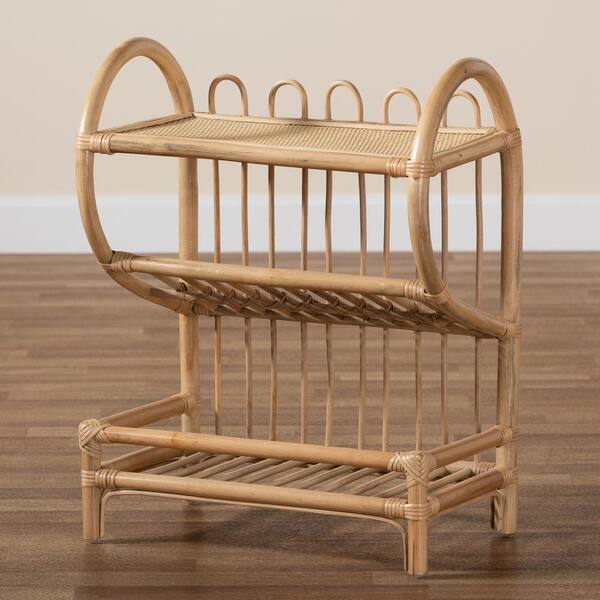
Rattan shelving and cabinets are crafted by combining rattan with other materials
The combination of rattan with other materials ensures the durability and sturdiness of the shelving units and cabinets. The rattan accents or baskets not only enhance the overall visual appeal but also add texture and visual interest to the furniture pieces.
Rattan's natural color variations and texture bring warmth and uniqueness to the storage solutions, making them standout pieces in any interior design.
Rattan desks and workstations are not only practical but also add a unique touch of style to any workspace. Crafted from rattan, these furniture pieces combine functionality with aesthetic appeal, creating an ideal environment for productivity and creativity.
Rattan desks are known for their stylish designs. They often feature intricate weaves or rattan details on the legs or surfaces, showcasing the craftsmanship and natural beauty of rattan. These intricate patterns add a touch of visual interest and elevate the overall aesthetic of the workspace.
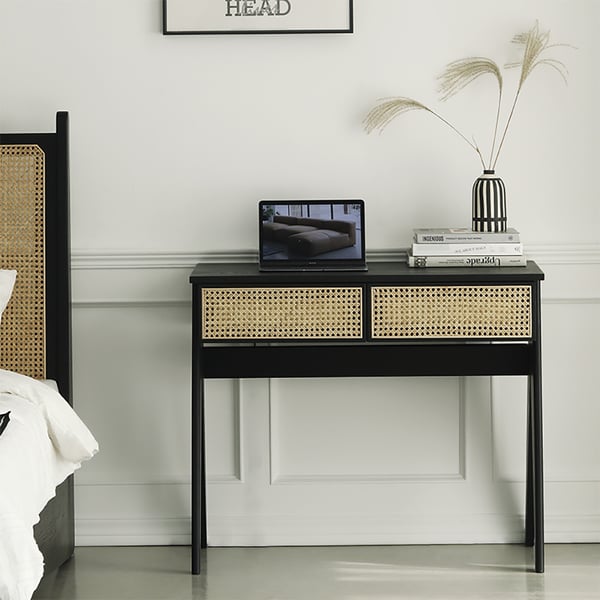
Rattan desks and workstations are both practical and stylish additions to any workspace
In addition to their visual appeal, rattan desks offer functionality. Rattan's durability ensures that these desks are sturdy and able to withstand regular use. The natural flexibility of rattan allows for the creation of ergonomic designs, providing a comfortable and supportive workspace.
What is rattan? Rattan is a flexible and durable material often used for weaving intricate patterns. In the case of headboards, rattan is expertly woven into intricate designs, creating a visually captivating piece of furniture that enhances the overall aesthetic of the bed. These headboards bring a unique touch to the sleeping space, creating an enchanting atmosphere.
Rattan headboards often feature intricate woven patterns or panels, showcasing the skilled craftsmanship and artistry of rattan weaving. These intricate designs enhance the overall aesthetic of the bed, becoming a focal point in the room and adding depth to the interior design.
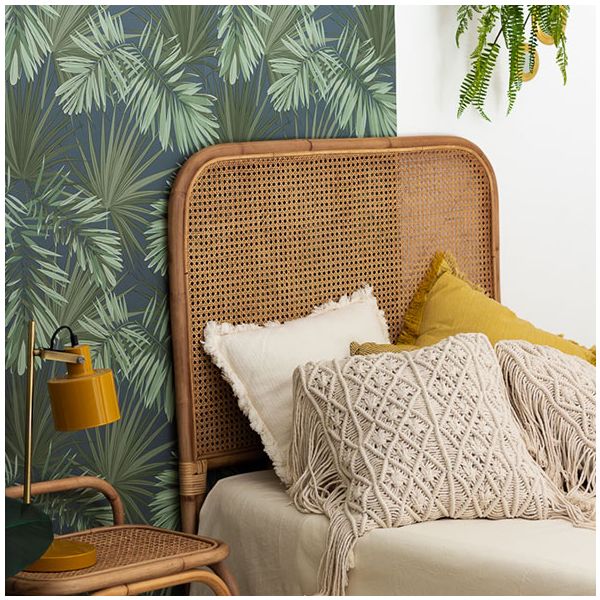
Rattan headboards enhance the overall aesthetic of the bed
Beyond their visual appeal, rattan headboards offer a variety of benefits. Firstly, they bring a natural element to the bedroom, infusing the space with a warm and organic feel. The texture of rattan adds tactile interest to the headboard, creating a visually and physically engaging experience.
Furthermore, rattan is a durable material, ensuring that the headboard will last for years to come. Its natural sturdiness and strength make it a practical choice for a functional piece of furniture, providing both support and style.
Rattan beds have become a popular trend in the world of furniture, offering a unique and tropical aesthetic. These beds are made using the flexible and durable material known as rattan, which comes from the old-world climbing palm plant. With their trendy tropical nature, rattan beds have garnered attention for their eye-catching appeal, both indoors and outdoors.
The design of rattan beds draws inspiration from the 1970s furniture design era, where many people utilized locally sourced reeds to create their furniture. This retro influence adds a nostalgic charm to rattan beds, evoking a laid-back and simple look reminiscent of countryside living.
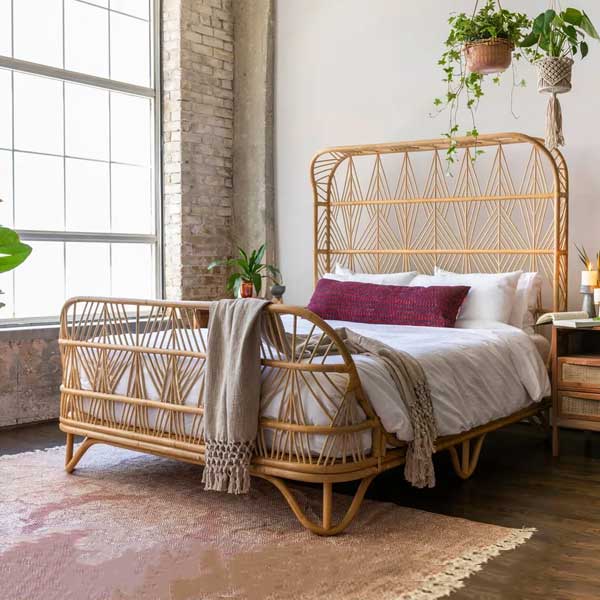
Rattan beds offer a unique and tropical aesthetic
While rattan beds may come with a higher price tag compared to traditional bed frames, they are well worth the investment for those seeking to embrace the modern trend. The versatility and durability of rattan ensure that these beds are not only aesthetically pleasing but also built to last.
To purchase rattan pendant lights, you have several options available. However, to choose quality and unique rattan pendant lights, we recommend two main options:
Explore these venues to find unique, handcrafted rattan pendant lights made by local artisans. This supports small businesses and provides you with one-of-a-kind pieces.
Visit home decor stores or lighting boutiques that offer a curated selection of rattan pendant lights. These stores provide personalized assistance and allow you to see the lights in person.

Rowabi - a reputable place to buy rattan pendant lights
Additionally, Rowabi has been a reputable store for pendant lighting and rattan decor for the past five years. Rowabi's rattan furniture is handcrafted by skilled artisans using high-quality rattan sourced from Southeast Asia. Each piece reflects meticulous craftsmanship and elegance.
Rowabi offers a wide range of rattan pendant light designs, from minimalist and modern to intricate and decorative, ensuring you find a light that fits your style and enhances your interior decor.
When shopping for rattan furniture, it's crucial to understand the factors that contribute to quality and value. Here are some detailed tips to guide you:
The weaving quality of rattan furniture is a key indicator of its value. High-quality pieces typically feature tightly stacked individual poles or strands. Furniture with between 2 and 10 strands is common, but pieces with 6 strands are particularly sought after due to their balance of strength and aesthetic appeal.
Inspect the color and texture of the rattan carefully. The uniform color and smooth texture indicate high-quality material. Dark spots or blemishes in the grain can detract from the piece's appearance and value, so look for furniture with a consistent finish.
The sharpness of the bends in rattan furniture is another sign of quality. Tighter curves are harder to achieve and indicate a higher level of craftsmanship. These sharper bends not only enhance the visual appeal but also demonstrate the skill involved in the furniture's creation.
Pay close attention to the wrapping around the joints where two poles meet. Intricate and elaborate wrapping signifies careful and skilled craftsmanship, making the piece more valuable. The more detailed the wrapping, the higher the quality and likely the durability of the furniture.
Ensure that the frame of the rattan furniture is sturdy and provides adequate support. A strong frame is essential for the longevity and usability of the furniture, as it needs to support the woven rattan structure without sagging or breaking.
Comfort and support are crucial when choosing rattan furniture. Sit on the furniture to test its comfort level and ensure it provides proper support. Quality rattan furniture should offer a comfortable seating experience without compromising on style.
Consider the maintenance requirements of rattan furniture. High-quality rattan typically requires minimal maintenance, but it's important to know how to care for your pieces to extend their longevity.
Regular dusting and occasional cleaning with a damp cloth can help maintain its appearance and durability.
Determine whether the furniture is intended for indoor or outdoor use. Outdoor rattan furniture should be treated to withstand the elements, such as UV rays, rain, and humidity. Indoor rattan can focus more on aesthetics and comfort without needing weather-resistant treatments.
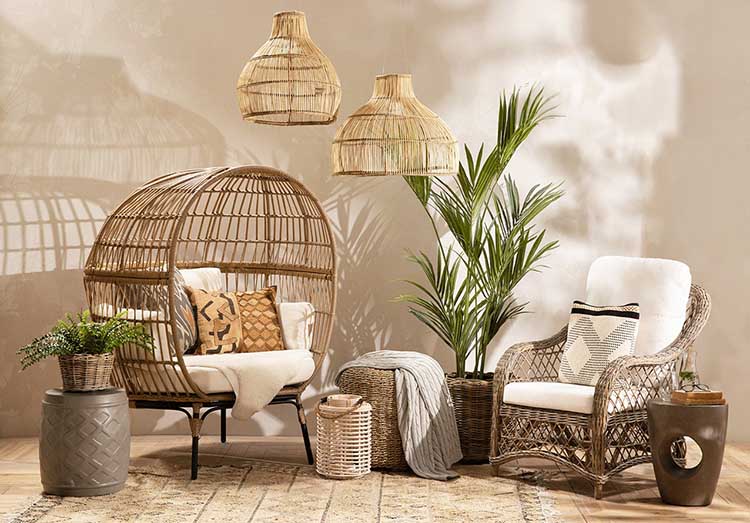
Here are the tips you need to know when choosing any rattan furniture piece
In recent years, and for the foreseeable future, rattan will undoubtedly maintain its position as a crucial material in every household for furniture making. Alongside being preserved as traditional handicraft products, rattan will also utilize various paint finishes to diversify colors and usage methods.
It will continue to replace materials in making items such as statement pieces like rattan armchairs and coffee tables, as well as pendant lights or accent decor items like mirrors, baskets, and planters.
Whether aiming for a bohemian, coastal, or minimalist style, rattan offers versatility and charm that can enhance your home's interior design.
What kind of material is rattan?
What are 3 products of rattan?
Is rattan like plastic?
Is rattan cheaper than wood?
Is rattan waterproof?
What are the 5 types of rattan?
What is more expensive, bamboo or rattan?
What country is the biggest rattan manufacturer?
What are the disadvantages of rattan furniture?
In conclusion, Rowabi has provided you with an answer to the question of "What is rattan?" and has shared information about the products made from rattan.
We hope that our informative blogs will assist you in selecting the appropriate rattan products for your home. Should you have any questions or need further clarification, please do not hesitate to contact us.

15+ Outdoor Wall Lighting Ideas for the Front of Your House in 2024
Many people believe that the warmth and welcoming nature of a home begin with the entryway, not just the interior. Therefore, creating a cozy atmosphere outdoors, especially around entryways, has b...
Read more
How To Choose The Right Pendant Lights For Your Home
Looking to brighten up your space with pendant lights but feeling a bit lost? Don't worry! Discover how to choose the perfect pendant lights for your home with our expert tips from Rowabi. With our...
Read moreGifting has never been easier
Perfect if you're short on time or are unable to deliver your gift yourself. Enter your message and select when to send it.

Leave a comment
This site is protected by hCaptcha and the hCaptcha Privacy Policy and Terms of Service apply.